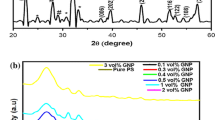Abstract
During past decades, both of interface polarization and electric percolation mechanisms have been found to have a significant influence on the dielectric and conductive properties of polymer based nanocomposites bearing electrically conducting nanoparticles. Although the significantly elevated high dielectric constant of composites has gained great success, the finely balanced high dielectric constant, depressed dielectric loss and low conductivity have been faced with a huge challenge. Instead of the high-cost organic modification onto the surfaces of inorganic conductive nanofiller, in current work, a small quantity of polyvinylpyrrolidone surfactant was introduced to prepare the ternary polymer based nanocomposite films bearing stannic oxide nanoparticles. Their dielectric and conductive performances were compared with that of the corresponding binary composites without bearing that surfactant. The positive influence of that surfactant on the finely balanced high comprehensive electric properties of composites namely high dielectric constant and depressed loss/conductivity was confirmed due to the improving of interface compatibility and depressing of interface air voids. The ternary nanocomposite bearing 10 vol% filler could have a dielectric constant of ca. 175, loss of ca. 0.35 and conductivity of ca. 1.8 × 10−5 S cm−1 at 1 kHz under 1 V bias voltage. This work might open the door to the large-scale fabrication of promising composite dielectrics materials by facilely introducing the third surfactant component.









Similar content being viewed by others
References
F. Piana, I. Cacciotti, M. Šlouf, J. Mater. Sci. 53, 11343–11354 (2018)
H. Tang, G. Chen, Q. Li, Mater. Lett. 184, 143–147 (2016)
L. Zheng, G. Liang, A. Gu, J. Mater. Chem. C 4, 10654–10663 (2016)
S. Dong, C. Baek, H. Ma, Ceram. Int. 42, 7141–7147 (2016)
C. Behera, R. Choudhary, P. Das, J. Electron. Mater. 46, 1–14 (2017)
Y. Feng, M. Li, W. Li, Appl. Phys. Lett. 112, 022901 (2018)
Z. Dang, M. Zheng, J. Zha, Small 12, 1688–1701 (2016)
S. Liu, M. Tian, L. Zhang, J. Mater. Sci. 51, 2616–2626 (2016)
M. Moussa, A. Ghoneim, M. Abdel Rehim, J. Appl. Polym. Sci. 134, 45415 (2017)
F. Bashir, T. Hussain, A. Mujahid, Polym. Compos. 39, E1052–E1059 (2017)
X. Liu, Z. Hou, B. Zhang, Appl. Phys. Lett. 108, 102902 (2016)
D. Nuzhnyy, J. Petzelt, V. Bovtun, Ferroelectrics 500, 1–19 (2016)
G. Chen, X. Wang, J. Lin, J. Phys. Chem. C 120, 28423–28431 (2016)
A. Magerramov, R. Mamedova, I. Ismailov, Tech. Phys. 62, 1377–1380 (2017)
Q. Jia, X. Huang, G. Wang, J. Phys. Chem. C 120, 10206–10214 (2016)
T. Wang, J. Hu, H. Yang, J. Appl. Phys. 121, 084103 (2017)
T. Tanaka, M. Kozako, N. Fuse, IEEE T. Dielect. Electr. Insul. 12, 669–681 (2005)
P. Steeman, F. Maurer, Colloid Polym. Sci. 270, 1069–1079 (1992)
M. Hori, S. Nemat-Nasser, Mech. Mater. 14, 189–206 (1993)
S. Das, P. Achary, N. Nayak, Polym. Compos. 37, 3398–3410 (2016)
P. Kumar, S. Yu, F. Shahzad, Carbon 101, 120–128 (2016)
M. Gao, P. Zhang, Acta Phys. Sin 24, 196–203 (2016)
Y. Qi, Q. Luo, J. Shen, Appl. Surf. Sci. 414, 147–152 (2017)
S. Liao, Z. Shen, H. Pan, J. Mater. Chem. C 5, 12777–12784 (2017)
Y. Feng, Z. Xu, J. Hu, Mater. Res. Express 4, 095001 (2017)
T. Dawin, Z. Ahmadi, F. Taromi, Prog. Org. Coat. 119, 23–30 (2018)
G. Singh, R. Thangaraj, R. Singh, Ceram. Int. 42, 4323–4332 (2016)
Y. Feng, B. Miao, H. Gong, ACS Appl. Mater. Interfaces 8, 19054–19065 (2016)
M. Ruan, D. Yang, W. Guo, Appl. Surf. Sci. 439, 186–195 (2018)
Z. Sun, C. Ma, M. Liu, Adv. Mater. 29, 1604427 (2017)
R. Alam, M. Moradi, H. Nikmanesh, Mater. Res. Bull. 73, 261–267 (2016)
O. Kozák, K. Datta, M. Greplová, J. Phys. Chem. C 117, 24991–24996 (2016)
P. Barik, A. Bhattacharjee, M. Roy, Polym. Composite 37, 108–114 (2016)
C. Lampadaris, E. Sakellis, A. Papathanassiou, Appl. Phys. Lett. 110, 222901 (2017)
X. Hong, D. Wang, D. Chung, J. Electron. Mater. 45, 453–461 (2016)
J. Li, J. Kim, Compos. Sci. Technol. 67, 2114–2120 (2007)
A. Burkhanov, K. Bormanis, G. Akbaeva, Ferroelectrics 508, 93–99 (2017)
P. Xu, W. Fu, Z. Cui, Appl. Phys. Lett. 112, 063904 (2018)
L. Gao, X. Yang, J. Hu, Mater. Lett. 171, 1–4 (2016)
Acknowledgements
This work was financially supported by the National Natural Science Foundation of China (Grant No. 51502309) and the Talent Introduction Scientific Research Initiation Projects of Yangtze Normal University (Grant Nos. 2017KYQD33 and 2017KYQD34).
Author information
Authors and Affiliations
Corresponding author
Ethics declarations
Conflict of interest
The authors declare that they have no conflict of interest.
Rights and permissions
About this article
Cite this article
Feng, Y., Peng, C., Deng, Q. et al. Finely depressed dielectric loss and conductivity achieved in high-kappa stannic oxide/polymer nanocomposites from surfactant-assisted electric percolation. J Mater Sci: Mater Electron 30, 2682–2692 (2019). https://doi.org/10.1007/s10854-018-0544-5
Received:
Accepted:
Published:
Issue Date:
DOI: https://doi.org/10.1007/s10854-018-0544-5




